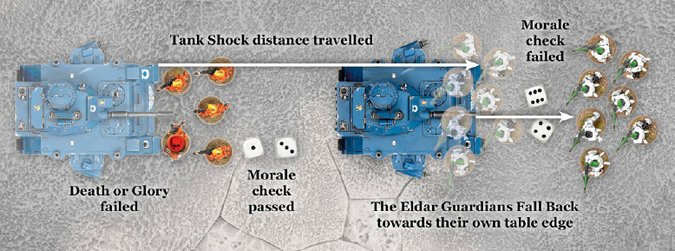Tanks can use their mass as a weapon, driving right into and through densely packed enemies. This often throws the opposing battle line into disarray, as having some monstrous metal behemoth coming straight at you is unnerving for anybody. When moving a vehicle with the Tank type, the player can declare that it is going to attempt to Tank Shock or Ram instead of moving normally.To perform a Tank Shock, first, turn the vehicle on the spot to face the direction you intend to move it and, after pre-measuring, declare how many inches the vehicle is going to move, up to its maximum speed. The vehicle must move at least Combat Speed. Note that, because pivoting on the spot does not count as moving, this is not enough for a Tank Shock. Once the Tank has been ‘aimed’ and the intended distance declared, move the Tank straight forwards until it comes into contact with an enemy unit or it reaches the distance declared – no other changes of direction are allowed in a Tank Shock. A Tank Shock is an exception to the rule that enemy models cannot be moved through. Remember, though, that friendly models still cannot be moved through, so the Tank’s movement will be stopped if any friendly models are in the way. Also, a Tank Shock cannot be attempted against enemies that are locked in combat, as the risk of harming allies is too high. If an enemy unit other than another vehicle is reached, that enemy unit must take a Morale check and immediately Fall Back if it fails. If the test is passed, the unit simply lets the Tank move through, as if it was not there. Regardless of the result of the test, the Tank keeps moving straight on, possibly Tank Shocking more enemy units until it reaches its final position. If the Tank would move into contact with a friendly model, enemy vehicle, impassable terrain or a board edge, it immediately stops moving 1" away. If some enemy models in the enemy unit would end up underneath the vehicle when it reaches its final position (it makes no difference whether the unit is Falling Back or not), these models must be moved out of the way by the shortest distance, leaving at least 1" between them and the vehicle whilst maintaining unit coherency and staying on the board. Any models that cannot manage this are crushed and removed from play as casualties with no saves allowed. Crunch!
If the model successfully manages to wreck the vehicle, or inflict a Crew Stunned, Immobilised or Explodes! result, the vehicle halts 1" away from the heroic individual (or blows up there). If the attack fails to stop the vehicle, then the Tank Shock continues as normal, except that the brave (but perhaps foolish) glory seeker is crushed by the vehicle grinding over him – the model is immediately removed as a casualty. Artillery units may attempt a Death or Glory attack with either a crewman (as normal) or a gun model. If a gun model does this and fails to stop the Tank, both the gun and one crewman are removed. Ramming is a rather desperate manoeuvre and the Tank must concentrate on moving at top speed towards one enemy vehicle. This means that it, and any embarked troops, may only shoot Snap Shots in that turn’s Shooting phase, making it a better idea for vehicles that have no armament left, or are Shaken. Ramming is a special type of Tank Shock and is executed the same way. Any vehicle that can Tank Shock can also Ram. Units other than vehicles in the path of a Ramming Tank are Tank Shocked as normal, but if the Ramming Tank comes into contact with an enemy vehicle or building, resolve the collision as follows. Each vehicle immediately suffers a hit against the armour facing where the other vehicle has impacted (so the Ramming vehicle always uses its front armour). The Strength of the hits will often be different for different vehicles, and is calculated as follows for each vehicle:
At the same time, the Land Raider suffers a Strength 5 hit against its front armour (for the Trukk’s side armour of 10, +0 because the Trukk is not a Tank), which stands no chance of damaging the mighty vehicle. Both players roll for armour penetration against their opponent’s vehicle and any results are immediately applied. If the vehicle that is Rammed is not removed, the Rammer halts. However, if the Rammed vehicle is removed because it suffers an Explodes! damage result, the Rammer continues its move until it reaches the declared distance, moves to within 1" of impassable terrain or friendly troops (at which point it stops immediately) or contacts another enemy unit (which it will Tank Shock or Ram again). FAQTank Shock
|


